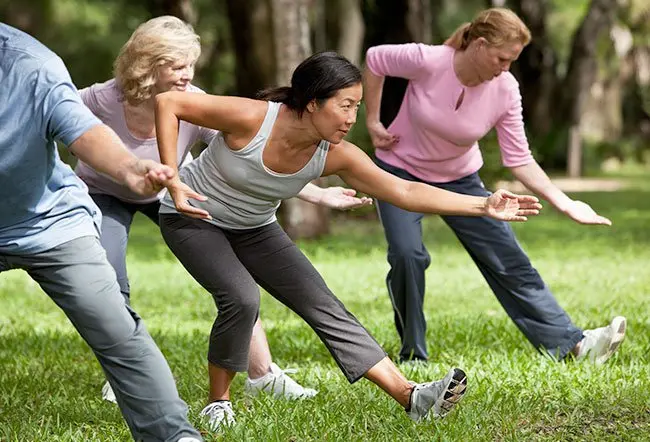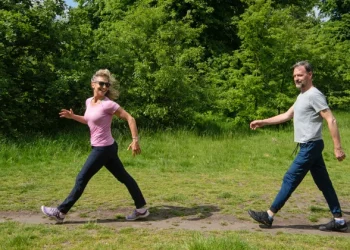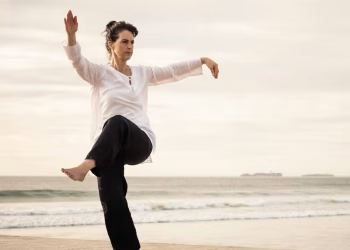In the practice of Tai Chi, every movement carries significance, and walking is no exception. The pace at which practitioners move through their forms and walking exercises profoundly influences the physical, mental, and energetic benefits they receive. Understanding how to calibrate your Tai Chi walking speed opens the door to a more nuanced and effective practice, whether you’re seeking improved balance, stress reduction, or deeper internal awareness.
The Philosophy of Pace in Tai Chi
Tai Chi walking encompasses both formal walking exercises, such as “cloud hands with stepping,” and the deliberate stepping patterns within Tai Chi forms. Unlike ordinary walking, Tai Chi walking emphasizes continuous, flowing movement with weight shifts executed with precise control and awareness. The speed at which you perform these movements directly impacts your ability to cultivate what practitioners call “internal strength” or “nei jin.”
Traditional Tai Chi philosophy suggests that slower is not always better, nor is faster necessarily more advanced. Instead, the optimal speed is one that allows you to maintain proper structure, continuous flow, and mindful awareness throughout each step. Master teachers often describe this as moving “like clouds drifting” or “like silk being drawn from a cocoon”—metaphors that emphasize smoothness and consistency rather than absolute speed.
Understanding Optimal Pace
The concept of optimal pace in Tai Chi walking varies considerably based on the practitioner’s experience level, physical condition, and practice objectives. However, certain principles remain constant across all skill levels.
For most practitioners, an optimal walking pace in Tai Chi takes approximately 3-8 seconds to complete a single step, from the moment weight begins shifting forward to when it settles completely into the front foot. This is dramatically slower than normal walking, which typically involves steps of less than one second. At this pace, you have sufficient time to observe the intricate details of weight transfer, maintain rooting through the weighted leg, and coordinate your breath with movement.
Beginners often benefit from practicing at the slower end of this spectrum—around 5-8 seconds per step. This extended timeframe provides the temporal space needed to think through proper alignment, adjust balance, and prevent the rushed movements that lead to tension and poor form. As coordination improves, many practitioners gradually increase their speed while maintaining the same quality of movement.
Advanced practitioners may work at various speeds depending on their training focus. Some days they might move extremely slowly—taking 10-15 seconds or more per step—to refine subtle details and develop extraordinary balance and leg strength. Other times, they might practice at a moderate pace of 2-4 seconds per step to explore the dynamic qualities of movement and develop practical martial applications.
How Speed Affects Physical Benefits
The relationship between walking speed and physical benefits in Tai Chi is multifaceted and worth examining in detail.
Balance and Stability: Slower speeds dramatically increase the balance challenge. When you move at a glacial pace, you must maintain single-leg stance for extended periods, which strengthens the small stabilizing muscles around your ankles, knees, and hips. Research has shown that slow, controlled single-leg standing is one of the most effective exercises for fall prevention in older adults. At very slow speeds (8+ seconds per step), you’re essentially performing extended single-leg stands with added complexity, making this an exceptional balance training exercise.
Muscular Strength and Endurance: The slower your Tai Chi walk, the greater the isometric and eccentric loading on your leg muscles. When you sink into a lower stance and move slowly, your quadriceps, glutes, and calves must work continuously to control your descent and support your body weight. A five-minute session of slow Tai Chi walking can produce muscle fatigue comparable to a much longer conventional workout, but with the added benefit of training muscles at longer lengths and promoting flexibility simultaneously.
Joint Health: Moderate speeds (3-6 seconds per step) appear optimal for joint health. This pace allows synovial fluid to circulate through the joints effectively while avoiding both the jarring impact of faster movements and the excessive compression of extremely slow movement. The gentle, continuous motion at this speed helps maintain cartilage health and can reduce stiffness associated with arthritis.
Cardiovascular Effects: While Tai Chi is generally considered a low-intensity exercise, your walking speed affects cardiovascular demand. Faster pacing (2-4 seconds per step), especially when combined with lower stances, can elevate heart rate into a moderate aerobic range. Conversely, very slow movement tends to keep heart rate lower, though it may still provide cardiovascular benefits through stress reduction and improved vagal tone.
Mental and Energetic Benefits Across Different Speeds
The pace of your Tai Chi walking profoundly influences mental states and energetic cultivation.
Meditative Depth: Extremely slow walking (8+ seconds per step) naturally induces meditative states. At this pace, the mind has no choice but to settle into the present moment; any wandering attention immediately manifests as wobbling or loss of balance. This makes ultra-slow Tai Chi walking an excellent moving meditation practice, comparable to sitting meditation in its capacity to cultivate one-pointed concentration and mindfulness.
Stress Reduction: Research suggests that moderate-paced Tai Chi (4-6 seconds per step) may be optimal for activating the parasympathetic nervous system and reducing cortisol levels. This pace is slow enough to feel distinctly meditative yet fast enough to maintain a sense of flow and momentum, preventing the anxiety some people experience when moving extremely slowly.
Qi Cultivation: In traditional Chinese medicine theory, different speeds affect how qi (vital energy) moves through the body. Very slow movement is said to allow practitioners to feel qi more distinctly and guide it more precisely through the meridians. Moderate speeds help develop the smooth, continuous circulation of qi. Faster speeds train the ability to mobilize qi quickly, which is important in martial applications.
Mental Acuity and Focus: Varying your speed from session to session or within a single practice session keeps your nervous system adaptable and your mind engaged. This variation prevents the autopilot mode that can develop when always practicing at the same pace.
Adjusting Speed for Different Purposes
Understanding how to adjust your Tai Chi walking speed for specific goals allows you to customize your practice to your current needs.
For Beginners: Start with a moderate pace of 5-7 seconds per step. This provides enough time to think through each element of proper form without the extreme balance challenge of ultra-slow movement. Focus on maintaining a smooth, continuous pace rather than stopping and starting. As you gain confidence, you can experiment with slightly slower speeds to deepen your practice.
For Balance Training: Practice at 8-12 seconds per step or slower. Work in this range 2-3 times per week for 10-15 minutes to see significant improvements in balance within several months. Begin with higher stances and progressively lower your center of gravity as your strength and stability improve.
For Cardiovascular Health: Use a brisker pace of 2-4 seconds per step combined with moderate-depth stances. Practice for 20-30 minutes to achieve aerobic benefits. You can incorporate intervals, moving slowly for several minutes, then increasing speed for 2-3 minutes before returning to a slower pace.
For Meditation and Stress Relief: Practice at 6-10 seconds per step, coordinating each step with several breath cycles. The coordination of movement and breath at this pace creates a powerful mind-body connection that facilitates deep relaxation and mental clarity.
For Martial Development: Advanced practitioners training martial applications should practice at variable speeds. Slow movement (8+ seconds per step) develops the sensitivity and precision needed to apply techniques correctly. Moderate speed (4-6 seconds per step) allows you to explore the dynamics of power generation. Occasional faster practice (2-3 seconds per step) helps bridge the gap between slow-form practice and real-time application.
For Rehabilitation: Those recovering from injury or surgery should consult with healthcare providers but generally start with the slowest comfortable pace (10+ seconds per step) in high stances. This minimal impact approach allows healing tissues to adapt gradually while maintaining neuromuscular coordination.
Practical Guidelines for Finding Your Pace
Determining your optimal Tai Chi walking speed requires experimentation and honest self-assessment. Begin each practice session with a few minutes of normal-paced walking to warm up, then gradually slow your pace until you reach a speed where you can maintain these qualities:
- Continuous, smooth movement without stops or jerky transitions
- Stable balance without excessive wobbling or needing to abort steps
- Relaxed breathing that can be coordinated naturally with movement
- Body alignment with proper posture maintained throughout each step
- Mental presence with focused attention rather than mind-wandering or strain
If you find yourself holding your breath, tensing your shoulders, or struggling to maintain balance, you’re likely moving too slowly for your current skill level. Conversely, if you can’t feel the weight shift clearly or if your movements feel rushed, you’re probably moving too quickly.
Tai Chi walking speed is not merely a technical detail but a fundamental aspect of practice that influences every benefit you receive. The optimal pace is not a fixed number but rather a dynamic variable that should adjust based on your experience, physical condition, and training objectives. By understanding how different speeds affect your body, mind, and energy, you can craft a Tai Chi walking practice that serves your evolving needs.
Whether you’re seeking improved balance, reduced stress, enhanced fitness, or deeper meditation, adjusting your walking speed provides a powerful tool for optimization. Start with moderate speeds that feel comfortable and sustainable, then gradually explore both slower and faster paces as your skills develop. Remember that consistency matters more than perfection—regular practice at any reasonable speed will yield benefits, while the perfect pace practiced rarely will not.
The journey of discovering your optimal Tai Chi walking speed is itself a form of practice, teaching patience, self-awareness, and adaptability. As you explore different paces, you’ll develop an intuitive sense of what your body and mind need on any given day, allowing you to use Tai Chi walking as a sophisticated tool for health, harmony, and personal cultivation.






